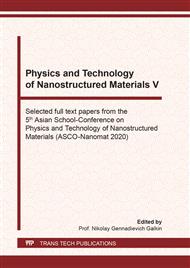[1]
A.B. Seabra, P. Haddad, N. Duran, Biogenic synthesis of nanostructured iron compounds: applications and perspectives, IET Nanobio- Technology 7 (2013) 90-99.
DOI: 10.1049/iet-nbt.2012.0047
Google Scholar
[2]
L. Sagnotti, Iron Sulfides, in: Encyclopedia of Geomagnetism and paleomagnetism, ed. by D. Gubbins and E. Herrero-Bervera, Springer, The Netherlands, 2007, p.454.
DOI: 10.1007/978-1-4020-4423-6
Google Scholar
[3]
M.J. Dekkers, H.F. Passier and M.A.A. Schoonen, Magnetic properties of hydrothermally synthesized greigite (Fe3S4) - II. High and low temperature characteristics, Geophys. J. Int. 141 (2000) 809 -819.
DOI: 10.1046/j.1365-246x.2000.00129.x
Google Scholar
[4]
J. Xia, J.Q. Jiao, B.L. Dai, W.D. Qiu, S.X. He, W.T. Qiu, P.K. Shen, L.P. Chen, Facile synthesis of FeS2 nanocrystals and their magnetic and electrochemical properties, RSC Advances 3 (2013) 6132-6140.
DOI: 10.1039/c3ra22405h
Google Scholar
[5]
Yu. V. Pustovit and A. A. Kordyuk. Metamorphoses of electronic structure of FeSe-based superconductors (Review article), Low. Temp. Phys. 42 (2016) 1268-1283.
DOI: 10.1063/1.4969896
Google Scholar
[6]
P. Terzieff and K. L. Komarek, The paramagnetic properties of iron selenides with NiAs-type structure, Monatsh. Chem. Chem. Mon. 109 (1978) 651–659.
DOI: 10.1007/bf00912781
Google Scholar
[7]
P. Terzieff and K. L. Komarek, The antiferromagnetic and ferrimagnetic properties of iron selenides with NiAs-type structure, Monatsh. Chem.Chem. Mon. 109 (1978) 1037–1047.
DOI: 10.1007/bf00913006
Google Scholar
[8]
L. M. Levinson and D. Treves, Mössbauer study of the magnetic structure of Fe7S8, J. Phys. Chem. Solids 29, (1968) 2227–2231.
DOI: 10.1016/0022-3697(68)90019-x
Google Scholar
[9]
I. S. Lyubutin, Chun-Rong Lin, K. O. Funtov, T. V. Dmitrieva, S. S. Starchikov, Yu-Jhan Siao, and Mei-Li Chen, Structural, magnetic, and electronic properties of iron selenide Fe6-7Se8 nanoparticles obtained by thermal decomposition in high-temperature organic solvents, J. Chem. Phys. 141 (2014) 044704.
DOI: 10.1063/1.4887356
Google Scholar
[10]
C-R Lin, Y-T Tseng, S.G. Ovchinnikov, R.D. Ivantsov, I.S. Edelman, A.S. Fedorov, A.A. Kuzubov, D.A. Fedorov, S.S. Starchikov, and I.S. Lyubutin, Fe3S4 and Fe3O4 magnetic nanocrystals: magnetooptical and Mössbauer spectroscopy study, Materials Research Express 1 (2014) 025033.
DOI: 10.1088/2053-1591/1/2/025033
Google Scholar
[11]
D.Z. Shen, J.Y. Zhang, B.S. Li, B.H. Li, Y.M. Lu, X.W. Fan, H. W. Liang, Ferromagnetic FeSe: Structural, electrical, and magnetic properties, Applied Physics Letters 88 (2006) 012505-1- 012505-3.
DOI: 10.1063/1.2159561
Google Scholar
[12]
Bruker AXS TOPAS V4: General profile and structure analysis software for powder diffraction data. – User's Manual. Bruker AXS, Karlsruhe, Germany, (2008).
Google Scholar
[13]
X. Wang, W. Cai, G. Wang, Z. Wua, and H. Zhao, One-step fabrication of high performance micro/nanostructured Fe3S4–C magnetic adsorbent with easy recovery and regeneration properties, Cryst. Eng. Comm. 15 (2013) 2956.
DOI: 10.1039/c3ce26856j
Google Scholar


